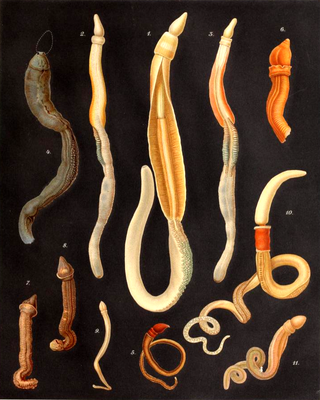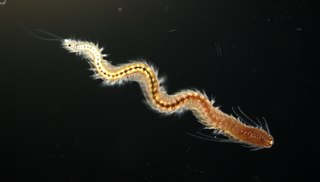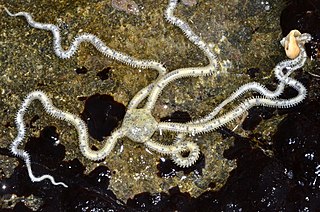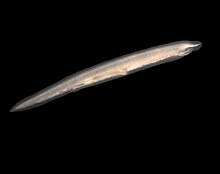
A chordate is a deuterostomic animal belonging to the phylum Chordata. All chordates possess, at some point during their larval or adult stages, five distinctive physical characteristics (synapomorphies) that distinguish them from other taxa. These five synapomorphies are a notochord, a hollow dorsal nerve cord, an endostyle or thyroid, pharyngeal slits, and a post-anal tail. The name "chordate" comes from the first of these synapomorphies, the notochord, which plays a significant role in chordate body plan structuring and movements. Chordates are also bilaterally symmetric, have a coelom, possess an enclosed circulatory system, and exhibit metameric segmentation.

A craniate is a member of the Craniata, a proposed clade of chordate animals with a skull of hard bone or cartilage. Living representatives are the Myxini (hagfishes), Hyperoartia, and the much more numerous Gnathostomata. Formerly distinct from vertebrates by excluding hagfish, molecular and anatomical research in the 21st century has led to the reinclusion of hagfish as vertebrates, making living craniates synonymous with living vertebrates.

A tunicate is a marine invertebrate animal, a member of the subphylum Tunicata. It is part of the Chordata, a phylum which includes all animals with dorsal nerve cords and notochords. The subphylum was at one time called Urochordata, and the term urochordates is still sometimes used for these animals. They are the only chordates that have lost their myomeric segmentation, with the possible exception of the 'seriation of the gill slits'. However, doliolids still display segmentation of the muscle bands.

In zoology and developmental anatomy, the notochord is an elastic rod-like structure found in many deuterostomal animals. Any species that has a notochord at any stage of its life cycle is, by definition, a chordate.

Palaeozoology, also spelled as Paleozoology, is the branch of paleontology, paleobiology, or zoology dealing with the recovery and identification of multicellular animal remains from geological contexts, and the use of these fossils in the reconstruction of prehistoric environments and ancient ecosystems.

Pikaia gracilens is an extinct, primitive chordate animal known from the Middle Cambrian Burgess Shale of British Columbia. Described in 1911 by Charles Doolittle Walcott as an annelid, and in 1979 by Harry B. Whittington and Simon Conway Morris as a chordate, it became the "one of the most famous early chordate fossils," or "famously known as the earliest described Cambrian chordate". It is estimated to have lived during the latter period of the Cambrian explosion. Since its initial discovery, more than a hundred specimens have been recovered.

A cephalochordate is an animal in the chordate subphylum Cephalochordata. Cephalochordates are commonly called lancelets, and possess 5 synapomorphies, or primary characteristics, that all chordates have at some point during their larval or adulthood stages. These 5 synapomorphies are a notochord, dorsal hollow nerve cord, endostyle, pharyngeal slits, and a post-anal tail. The fine structure of the cephalochordate notochord is best known for the Bahamas lancelet, Asymmetron lucayanum. Cephalochordates are represented in modern oceans by the Amphioxiformes and are commonly found in warm temperate and tropical seas worldwide. With the presence of a notochord, adult amphioxus are able to swim and tolerate the tides of coastal environments, but they are most likely to be found within the sediment of these communities.

The lancelets, also known as amphioxi, consist of some 30 to 35 species of "fish-like" benthic filter feeding chordates in the order Amphioxiformes. They are modern representatives of the subphylum Cephalochordata. Lancelets closely resemble 530-million-year-old Pikaia, fossils of which are known from the Burgess Shale. However, according to phylogenetic analysis, the lancelet group itself probably evolved around the Cretaceous, 97.7 million years ago for Pacific species and 112 million years ago for Atlantic species. Palaeobranchiostoma from the Permian may be part of the fossil record of lancelets; however, due to poor preservation, some doubt about its nature remains. Zoologists are interested in them because they provide evolutionary insight into the origins of vertebrates. Lancelets contain many organs and organ systems that are closely related to those of modern fish, but in a more primitive form. Therefore, they provide a number of examples of possible evolutionary exaptation. For example, the gill-slits of lancelets are used for feeding only, and not for respiration. The circulatory system carries food throughout their body, but does not have red blood cells or hemoglobin for transporting oxygen. Lancelet genomes hold clues about the early evolution of vertebrates: by comparing genes from lancelets with the same genes in vertebrates, changes in gene expression, function and number as vertebrates evolved can be discovered. The genome of a few species in the genus Branchiostoma have been sequenced: B. floridae,B. belcheri, and B. lanceolatum.

The acorn worms or Enteropneusta are a hemichordate class of invertebrates consisting of one order of the same name. The closest non-hemichordate relatives of the Enteropneusta are the echinoderms. There are 111 known species of acorn worm in the world, the main species for research being Saccoglossus kowalevskii. Two families—Harrimaniidae and Ptychoderidae—separated at least 370 million years ago.
Myomeres are blocks of skeletal muscle tissue arranged in sequence, commonly found in aquatic chordates. Myomeres are separated from adjacent myomeres by connective fascia (myosepta) and most easily seen in larval fishes or in the olm. Myomere counts are sometimes used for identifying specimens, since their number corresponds to the number of vertebrae in the adults. Location varies, with some species containing these only near the tails, while some have them located near the scapular or pelvic girdles. Depending on the species, myomeres could be arranged in an epaxial or hypaxial manner. Hypaxial refers to ventral muscles and related structures while epaxial refers to more dorsal muscles. The horizontal septum divides these two regions in vertebrates from cyclostomes to gnathostomes. In terrestrial chordates, the myomeres become fused as well as indistinct, due to the disappearance of myosepta.

Marine invertebrates are the invertebrates that live in marine habitats. Invertebrate is a blanket term that includes all animals apart from the vertebrate members of the chordate phylum. Invertebrates lack a vertebral column, and some have evolved a shell or a hard exoskeleton. As on land and in the air, marine invertebrates have a large variety of body plans, and have been categorised into over 30 phyla. They make up most of the macroscopic life in the oceans.

Lampreys are an ancient extant lineage of jawless fish of the order Petromyzontiformes, placed in the superclass Cyclostomata. The adult lamprey may be characterized by a toothed, funnel-like sucking mouth. The common name "lamprey" is probably derived from Latin lampetra, which may mean "stone licker", though the etymology is uncertain. Lamprey is sometimes seen for the plural form.

Branchiostoma is one of the few living genera of lancelets. It is the type genus of family Branchiostomatidae.
Branchiostoma floridae, the Florida lancelet, is a lancelet of the genus Branchiostoma. The genome of this species has been sequenced, revealing that among the chordates, the morphologically simpler tunicates are actually more closely related to vertebrates than lancelets. An embryo of a Florida amphioxus has a larval pharynx with gill slits that is asymmetrical. The gill slits in the larval pharynx form in the center of the embryo when it is in its earliest stage of development (primordial) meaning the thick layer of endoderm is overlapped by a thin layer; which aids into making the B. floridae asymmetrical from left to right. The lancelet Branchiostoma floridae maintains a high level of Fox transcription factor gene diversity, with 32 distinct Fox genes in its genome, and 21,229 clusters of cDNA clones, making it very useful to the research community.

Platynereis dumerilii is a species of annelid polychaete worm. It was originally placed into the genus Nereis and later reassigned to the genus Platynereis. Platynereis dumerilii lives in coastal marine waters from temperate to tropical zones. It can be found in a wide range from the Azores, the Mediterranean, in the North Sea, the English Channel, and the Atlantic down to the Cape of Good Hope, in the Black Sea, the Red Sea, the Persian Gulf, the Sea of Japan, the Pacific, and the Kerguelen Islands. Platynereis dumerilii is today an important lab animal, it is considered as a living fossil, and it is used in many phylogenetic studies as a model organism.
In biology, solenocytes are elongated, flagellated cells commonly found in lower invertebrates, such as flatworms, as well as in chordates and several other animal species. In terms of function, solenocytes play a significant role in the excretory systems of their host organism(s). For example, the lancelets, also referred to as amphioxus, utilize solenocytic protonephridia to perform excretion. In addition to excretion, these cells contribute to ion regulation and osmoregulation. With this in mind, solenocytes form subtypes of protonephridium and are often compared to another specialized excretory cell type, i.e., flame cells. Solenocytes have flagella, while flame cells are generally ciliated.

MirGeneDB is a database of manually curated microRNA genes that have been validated and annotated as initially described in Fromm et al. 2015 and Fromm et al. 2020. MirGeneDB 2.1 includes more than 16,000 microRNA gene entries representing more than 1,500 miRNA families from 75 metazoan species and published in the 2022 NAR database issue. All microRNAs can be browsed, searched and downloaded.

Amphiodia occidentalis or long-armed brittle star is a species of brittle star belonging to the family Amphiuridae. It is found in the Eastern Pacific coast from Alaska to USA, often on the seafloor within intertidal and subtidal zones. Within these areas, it is often found buried a few centimeters under the sand with 2 or 3 arms extending through the surface.
Linda Zimmerman Holland is a research biologist at Scripps Institution of Oceanography known for her work examining the evolution of vertebrates.
Amphioxus or lancelets (Branchiostoma) are members of the Chordata phylum of which all members have a notochord at some point while they are alive. B. belcheri have a notochord, dorsal nerve cord, pharynx, buccal cavity, cirri, tail, dorsal fin, nerve cord, segmented muscle, and ocelli. They are distinguishable by a slightly round dorsal fin, eighty slender preanal fin-chambers, narrow caudal fin, and obtuse angles between fins. They obtain food by filter feeding. They were first reported in 1897 near the Amakusa Islands, specifically off Goshonoura Island, south of Amakusa-Kamishima Island. These islands are located on the west coast of Kyushu, the island furthest south of the four main isles of Japan. In addition to the location of the siting, information regarding reproductive period and morphology was also obtained. B. belcheri are gonochoric, reproducing via external fertilization. B. belcheri are an endangered species, threatened by the influx of pollutants of land-based origin into the sea such as cleaning agents, chemical waste, garbage, mining waste, pesticides, petroleum products, and sewage.














